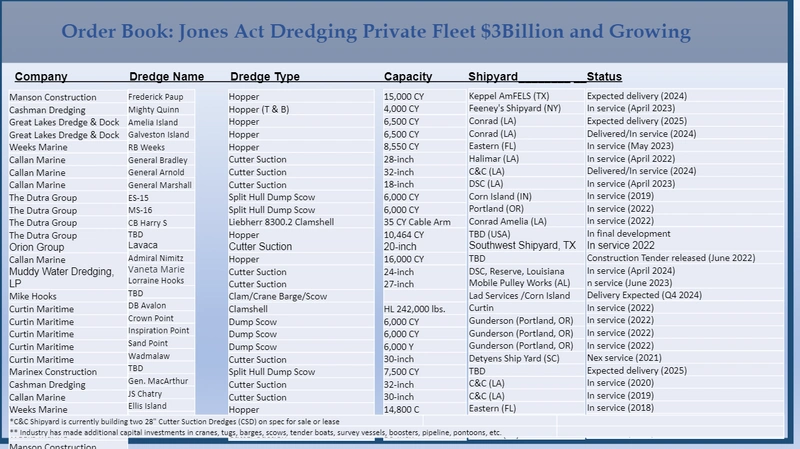Fierce Competition Drives Down the Cost of US Dredging Projects
Heavy competition within the U.S. dredging sector helps to save American taxpayers hundreds of millions of dollars each year, as highlighted by a recent industry report.
According to the "U.S. Dredging Report: An Analysis of the FY23 U.S. Federal Dredging Market", compiled by dredging industry insider Michael Gerhardt, highly competitive U.S. dredging companies saved taxpayers $707 million for contracts awarded by the U.S. Army Corps of Engineers (USACE) in FY 2023 alone.

The USACE awards a diverse array of dredging projects, ranging from maintaining and deepening ports and navigational channels to environmental restoration and shoreline protection. These projects are essential for ensuring safe and efficient maritime transport, flood risk reduction and ecosystem health.
In total, 56 different companies were awarded USACE dredging work in FY23, including 21 large and 34 small businesses. Each project, including both unrestricted and small business set-aside projects, as well as hopper dredge projects, received an average of three bidders, helping to keep costs low.
“The private sector U.S. dredging industry continues to be highly competitive, innovative and saves the country hundreds of millions in tax payer dollars,” said William P. Doyle, CEO of the trade group Dredging Contractors of America (DCA).
The industry low bid compared to the Government Estimate (GE) and Government Estimated Awardable Range (GEAR) accounts for the following:
- 135 of the 163 projects have available industry bid/GE comparisons and were not sole-sourced: 85 of the 135 (63%) had a winning bid lower than the GE; and 126 of the 135 (93%) had a winning bid lower than the GEAR.
- Of the 85 projects where industry was lower than the base GE, 63 projects were cheaper by more than 10%; 32)projects by more than 25%; 11 by more than 40%; and four by more than 50%.
- The savings to the United States is $707,332,283. This is an average savings of tax payer dollars of 35% per project when compared to the GEAR.
FY23 was also a record year in terms of contracts awarded, with nearly $2.1 billion in USACE dredging contracts awarded, a 39% increase from FY22 and 20% above the $1.7 billion seven-year average.
According to Doyle, this record demand is leading the Jones Act dredging industry to invest heavily in its fleet.
In addition, more USACE dredging projects are incorporating beneficial use of dredged material, Doyle added, noting the Corps has a set a goal of reusing 70% of dredged material for beneficial uses by 2030.
Reusing dredged material excavated from the seafloor, river and lake bottoms is known as beneficial use of dredged material. Such uses include rebuilding barrier islands, fish and wildlife habitat creation and restoration, beach nourishment, landfill cover, human recreation and land site remediation. Beneficial use of dredged material in a harbor can have a significant impact on improving the condition of the harbor while also alleviating existing demand for development and use of new disposal sites.
In FY23, 66% of the overall federal dredging program totaling 107 projects incorporated the use of dredged material for beneficial purposes, compared to 59%, a total of 87 projects in FY22.
“The industry is recapitalizing its fleet of dredges and equipment and helping the Army Corps of Engineers meet its 70% goal of reusing dredge material for beneficial projects like shoreline stabilization, barrier island restoration and securing fish and wildlife habitat,” Doyle said.

